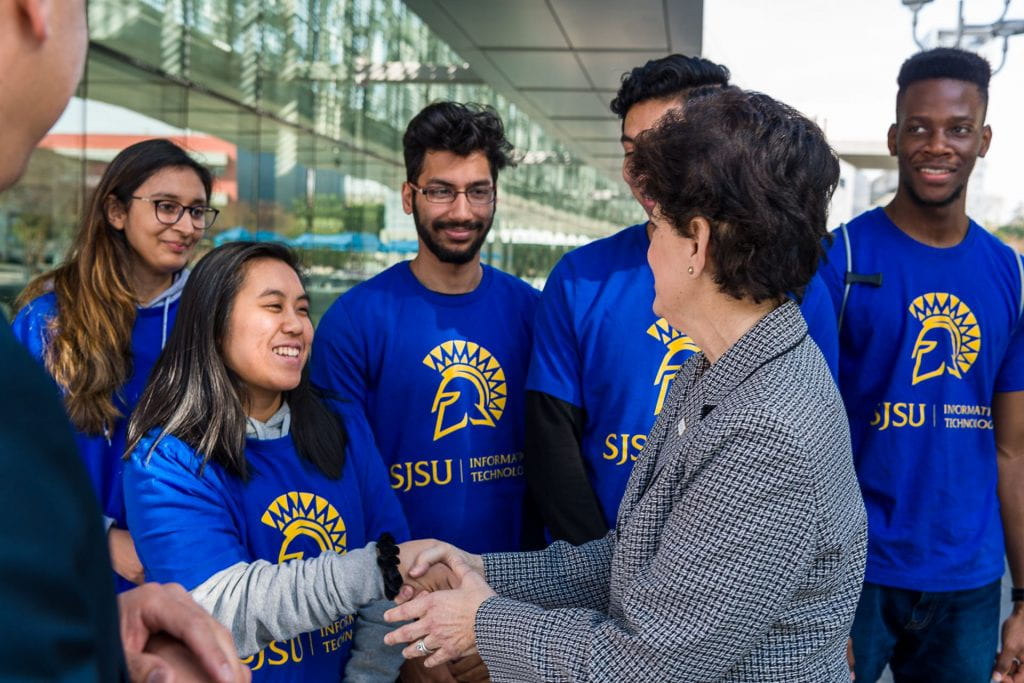Dr. Mary A. Papazian
How can higher education most effectively make use of today’s technology? It is a straightforward question, yet stunningly complex at the same time.
San Jose State, as is fitting for Silicon Valley’s public university, continues to forge strong ties with our region’s technology companies. We recently announced an exciting new partnership with IBM, for instance, that aims to better equip our students with the advanced tech skills they will need to compete in our global economy. In addition, we recently hosted leaders from various universities across the country for a two-day workshop with LinkedIn, where issues related to the future of work were explored.
So at SJSU, we embrace technological innovation and are especially keen to look at ways in which technology can help our students and our campus operations.
How technology and education can work hand in hand, in fact, was a central part of the discussion when we hosted Nobel Peace Prize Laureate Malala Yousafzai and Apple CEO Tim Cook on our campus in December. Apple and the Malala Fund are partnering to help more than 100,000 girls with their educational pursuits, and technology is a key element for enabling those opportunities.
At the same time, however, I have been examining the more challenging aspects of technology, particularly as they relate to colleges and universities.
In October, I had an opportunity to attend the World Congress on Information Technology (WCIT) in Armenia, where I participated in a panel discussion titled “Miseducation: Technology and the Individual” and offered the keynote address. We explored a number of important questions, such as how we can shield the next generation—including today’s college students—against the perils of our digital age, and how we might ensure that this generation will interact more responsibly with technology than we have done thus far.
By “perils” of our digital age, I am referring to issues we learn about routinely these days in the news media, oftentimes involving large tech companies whose products influence all of us.
Whether we are talking about privacy, ethics, accountability, data collection, cyber-attacks or a host of other concerns, many leaders across the globe are thinking more and more about how we can collectively rule technology more effectively—rather than have technology rule us.
The current literature on these issues is expanding.
For example, I can recommend Tools and Weapons, a new work by Microsoft president Brad Smith, and Zucked, by Roger McNamee. Each offer insightful and very personal commentary on the authors’ experiences with Microsoft and Facebook, respectively, and the potential pitfalls we now face when technology is allowed to run amok without mindful governance and corporate responsibility. Even the mere 3-word title of Smith’s book tells us a lot about how many of today’s technical products can serve dual purposes depending on the intent of the user.
In addition, philosophy professor Dr. Regina Rini of York University in Toronto has written enlightening pieces in the New York Times about how technology has given rise to misinformation, and how society needs to better prepare itself for the onslaught of fabricated but convincing video “news.”
But where the research appears thin is how higher education is impacted by all of this, and how universities and colleges can and should play a role. That is why San Jose State, with its Silicon Valley location and its earned reputation as a convener of conversations about challenging issues, wants to lead on these issues.
I noted earlier that college campuses are power users of technology, both in and out of the classroom. Consider safety, for instance, and the various technical products and services now being deployed on campuses around the country. Surveillance cameras are probably the most common and well known of these technologies, but there are many others that help campus police perform their jobs effectively to keep students and other members of the campus community safe.
But cameras and other technologies introduce privacy issues and ethical matters. The same can be said for data that may be collected on individuals, and a host of other practical issues. How can tech solutions be used in ways that align with our values? Who will construct and govern the rules? Who will be accountable if something goes wrong?
As a university president, particularly one leading Silicon Valley’s public university, I want to tackle and help shed light on these questions. To do that, I will need input and perspectives from various stakeholders, including our students, faculty, deans, tech partners and others.
Over the next year, we hope to engage the campus in conversations related to this topic. I would also love to explore and learn from the ideas, perspectives and lessons that other university presidents can provide. My higher education colleagues in or near Silicon Valley are a natural place to start since we are all so exposed to the debates and discussions that take place organically here in our region.
As I have written about elsewhere, there will need to be a strong intersection between creativity and innovation and tech skills if all of the emerging technologies are truly to succeed. Our role as educators is to ensure we provide a real education and equip our students to thrive in the digital age. We must be intentional about avoiding tech’s potential missteps.
Will we be part of the problem, or part of the solution? The challenge, the responsibility and the choices are ours.
